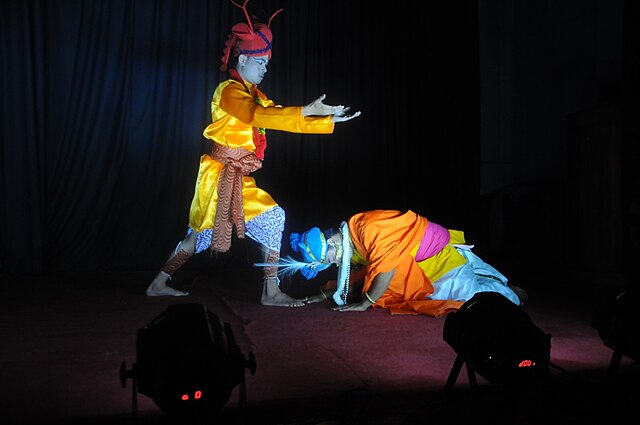Have you ever witnessed a dance so ethereal that it seems to transport you to another realm? That’s the magic of Manipuri dance – a classical Indian dance form that’s as spiritually enriching as it is visually stunning. This ancient art form from the northeastern state of Manipur has been captivating audiences for centuries with its graceful movements, devotional themes, and profound cultural significance.
What is Manipuri Dance?
Manipuri dance is one of India’s eight classical dance forms, recognized for its unique blend of grace, spirituality, and cultural richness. Unlike other classical dances that often emphasize sharp, angular movements, Manipuri dance flows like water, with soft, rounded gestures that mirror the gentle nature of the Manipuri people.
Origins and Historical Background
The roots of Manipuri dance stretch back over 2,000 years, deeply intertwined with the history and mythology of Manipur. Legend has it that the dance form originated when the gods themselves danced in the scenic valleys of Manipur. The region’s conversion to Vaishnavism in the 18th century under King Bhagyachandra significantly shaped the dance’s devotional character.
Archaeological evidence and ancient texts suggest that dance was an integral part of Manipuri society long before the Vaishnava influence. The Lai Haraoba festival, celebrating local deities, showcases some of the oldest forms of Manipuri dance that predate the Krishna-centered performances we see today.
Cultural Significance in Manipur
In Manipuri society, dance isn’t just entertainment – it’s a way of life. From birth to death, every significant life event in Manipur is marked by dance. Children learn to dance almost as naturally as they learn to walk, and the art form serves as a bridge connecting the community to its ancestors, deities, and cultural identity.
The dance plays a crucial role in preserving Manipuri language, literature, and oral traditions. Through dance dramas and performances, stories from the Puranas, local legends, and historical events are passed down from generation to generation.
The Spiritual Essence of Manipuri Dance
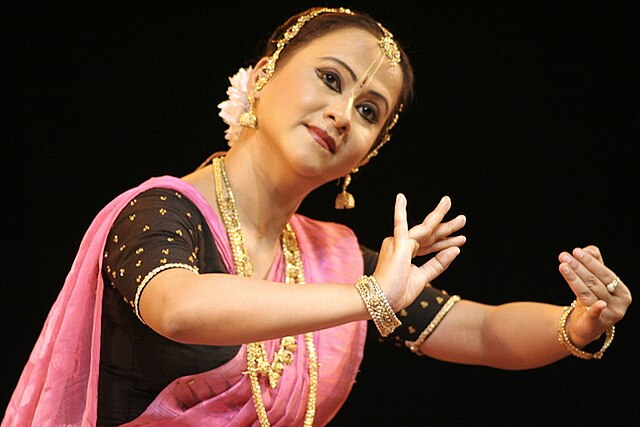
What sets Manipuri dance apart from other classical forms is its profound spiritual foundation. This isn’t just about technique or aesthetics – it’s about connecting with the divine.
The influence of Vaishnavism transformed Manipuri dance into a powerful medium of devotion. The dance form celebrates the love between Radha and Krishna, with performers often entering a meditative state during their performances. The spiritual preparation before each performance includes prayers, fasting, and mental purification.
Many dancers describe experiencing transcendent moments during performance, where the boundary between the dancer and the divine dissolves. This spiritual dimension attracts not just performers but audiences who seek a deeper, more meaningful cultural experience.
Dance as Divine Expression
In Manipuri philosophy, dance is considered a form of yoga – a path to spiritual enlightenment. The circular movements, symbolic of the cosmic dance of creation, help dancers achieve mental peace and spiritual harmony. The dance form teaches that through dedication and pure intention, art can become a vehicle for spiritual growth.
Key Characteristics of Manipuri Dance
Recognizing Manipuri dance is easy once you know what to look for. The form has several distinctive features that set it apart from other classical dances.
Graceful Movements and Postures
The hallmark of Manipuri dance is its incredible grace. Movements flow seamlessly from one to another, like a gentle stream finding its path. The dancer’s feet barely leave the ground, creating an impression of floating rather than walking. This earth-bound quality symbolizes humility and connection to Mother Earth.
The upper body movements are equally mesmerizing, with subtle hand gestures (mudras) conveying complex emotions and stories. The head movements are gentle and never jerky, maintaining the overall sense of serenity that defines this dance form.
Distinctive Costume and Makeup
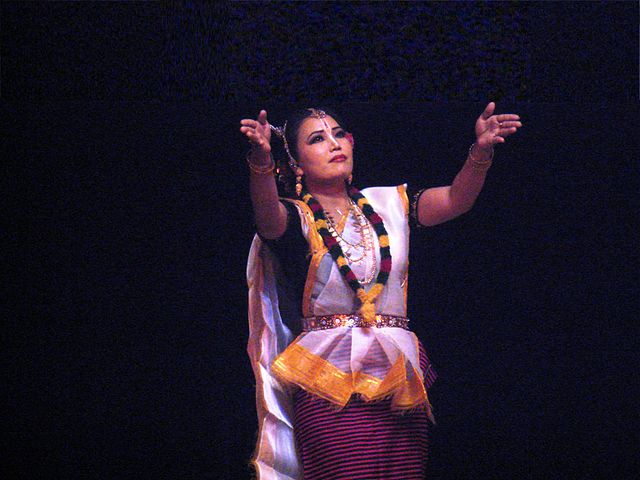
The visual appeal of Manipuri dance is enhanced by its stunning costumes and makeup, each element carrying symbolic meaning.
Traditional Attire for Female Dancers
Female dancers wear the iconic ‘Potloi’ – a richly embroidered, barrel-shaped skirt that’s both beautiful and functional. The skirt’s design allows for the flowing movements while creating a stunning visual effect as it sways with the dance. The intricate mirror work and golden threads catch the light, adding to the ethereal quality of the performance.
The blouse, called ‘Choli,’ is fitted and decorated with similar embroidery. A transparent veil (Odhani) completes the costume, often adorned with golden borders and delicate patterns.
Male Dancer Costumes
Male dancers, particularly those portraying Krishna, wear colorful dhoti with intricate borders. The costume includes a decorated jacket and an elaborate peacock-feathered crown. The makeup is more dramatic, with bold colors highlighting facial features and expressing the character being portrayed.
Major Styles and Forms of Manipuri Dance
Manipuri dance encompasses several distinct styles, each with its own purpose and aesthetic.
Raas Leela
Perhaps the most famous form of Manipuri dance, Raas Leela depicts the divine love story of Radha and Krishna. Performed traditionally by young girls, this dance form is characterized by circular movements that represent the cosmic dance of the universe. The performance often takes place during the full moon nights of spring, creating a magical atmosphere that enhances the spiritual experience.
The Raas Leela requires precise coordination among multiple dancers, as they weave intricate patterns while maintaining the story’s emotional flow. Each movement has symbolic meaning, from the gentle swaying that represents love’s joy to the momentary separations that echo the pain of divine longing.
Sankirtana
Sankirtana combines dance, music, and devotional singing in a powerful spiritual practice. Recognized by UNESCO as an Intangible Cultural Heritage of Humanity, Sankirtana performances can last for hours, creating a trance-like state among participants and audiences alike.
The dancers, accompanied by traditional drums and cymbals, create complex rhythmic patterns that build in intensity throughout the performance. This form requires exceptional stamina and spiritual preparation, as performers often continue dancing from dusk until dawn.
Thang-Ta (Martial Arts Dance)
This unique form combines martial arts with dance, showcasing the warrior tradition of Manipur. Thang-Ta incorporates sword and spear movements into graceful dance sequences, demonstrating that strength and grace can coexist beautifully.
Originally developed for warfare, Thang-Ta has evolved into a performance art that celebrates Manipuri martial heritage while maintaining the aesthetic principles of classical dance.
Musical Elements in Manipuri Dance
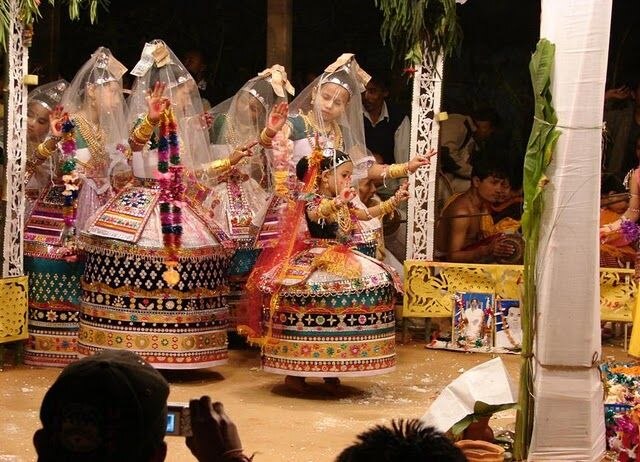
Music and dance in Manipuri tradition are inseparable partners, each enhancing the other’s beauty and meaning.
Traditional Instruments
The pung (traditional drum) is the heartbeat of Manipuri dance. This double-headed drum produces a wide range of sounds, from gentle whispers to thunderous beats. Skilled pung players are highly respected in Manipuri society, as their rhythm guides the entire performance.
Other important instruments include the flute (representing Krishna’s divine music), cymbals, and the esraj (a string instrument that adds melodic depth to performances).
Vocal Accompaniment
The vocal tradition in Manipuri dance includes both classical ragas and folk melodies. Singers often narrate the story through their songs, providing context and emotional depth to the dance performance. The lyrics, usually in Manipuri or Sanskrit, add another layer of cultural authenticity to the art form.
Learning Manipuri Dance: A Journey of Dedication
Becoming proficient in Manipuri dance requires years of dedicated practice and spiritual preparation.
Basic Training Requirements
Traditional training begins in early childhood, with students learning basic postures and movements before progressing to complex choreography. The training emphasizes discipline, respect for teachers, and spiritual development alongside technical skills.
Students start with simple exercises to develop flexibility and stamina, gradually incorporating more complex movements and emotional expressions. The learning process is holistic, encompassing not just physical technique but also the cultural and spiritual dimensions of the art form.
Famous Gurus and Dance Schools
Renowned gurus like Guru Bipin Singh, Rajkumar Singhajit Singh, and Darshana Jhaveri have played crucial roles in preserving and promoting Manipuri dance. These masters have established dance schools and trained countless students who now carry forward the tradition.
The Jawaharlal Nehru Manipur Dance Academy and various cultural centers across India offer structured training programs, making this beautiful art form accessible to dedicated learners worldwide.
Manipuri Dance on the Global Stage
The beauty and spirituality of Manipuri dance have transcended geographical boundaries, earning recognition and appreciation worldwide.
International Recognition
Manipuri dance has been performed in prestigious venues across the globe, from Lincoln Center in New York to the Royal Opera House in London. International audiences are consistently moved by the dance’s spiritual depth and artistic excellence.
The form has also influenced contemporary choreographers and dancers worldwide, who incorporate Manipuri techniques and aesthetics into modern dance compositions.
Cultural Ambassadors
Manipuri dancers serve as cultural ambassadors, sharing India’s rich artistic heritage with global audiences. Through international tours, workshops, and cultural exchange programs, they build bridges between cultures while preserving their traditional art form.
Challenges Facing Manipuri Dance Today
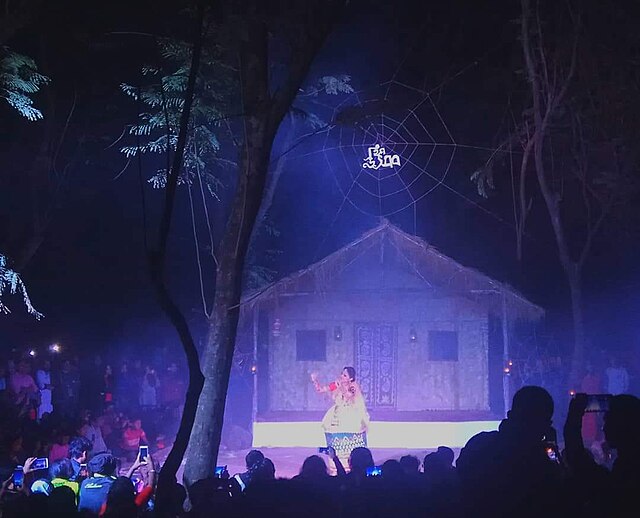
Despite its beauty and cultural significance, Manipuri dance faces several challenges in the modern world.
Preservation Efforts
The oral tradition that has preserved Manipuri dance for centuries is under threat from modernization and changing lifestyles. Efforts are underway to document traditional knowledge, create digital archives, and establish more formal training institutions.
Government and non-government organizations are working together to ensure that this precious art form doesn’t lose its authenticity while adapting to contemporary realities.
Modern Adaptations
Contemporary choreographers are experimenting with fusion forms, blending Manipuri dance with other styles. While this creates new artistic possibilities, it also raises questions about maintaining traditional integrity.
The challenge lies in finding the right balance between innovation and preservation, ensuring that Manipuri dance continues to evolve while retaining its spiritual essence and cultural authenticity.
Why Manipuri Dance Matters in Today’s World
In our fast-paced, technology-driven world, Manipuri dance offers something increasingly rare – a chance to slow down, connect with something deeper, and experience beauty that nourishes the soul.
The dance form teaches us about patience, dedication, and the power of tradition. It reminds us that some things cannot be rushed or digitized – they must be felt, experienced, and passed down through human connection.
For practitioners, Manipuri dance provides a path to physical fitness, mental peace, and spiritual growth. For audiences, it offers a window into a rich cultural heritage and a reminder of art’s power to transform and inspire.
As we face global challenges and increasing cultural homogenization, preserving and promoting diverse art forms like Manipuri dance becomes more crucial than ever. These traditions carry the wisdom of generations and offer alternative ways of understanding beauty, spirituality, and human expression.
Conclusion
Manipuri dance stands as a testament to the power of art to transcend boundaries and touch hearts across cultures and generations. This sacred dance form, with its perfect blend of grace, spirituality, and cultural richness, continues to inspire and transform lives around the world.
Whether you’re drawn to its spiritual depth, artistic beauty, or cultural significance, Manipuri dance offers something profound for everyone. As we move forward into an increasingly connected world, preserving and celebrating such traditional art forms becomes not just a cultural responsibility but a gift to future generations.
The gentle movements, devotional themes, and timeless stories of Manipuri dance remind us that some forms of beauty are eternal – they speak to something deep within the human spirit that transcends time, place, and circumstance. In a world that often seems to prioritize speed over depth, Manipuri dance invites us to slow down, breathe deeply, and remember what it means to be truly moved by art.
Frequently Asked Questions
1. How long does it take to learn Manipuri dance professionally? Learning Manipuri dance professionally typically takes 8-12 years of dedicated practice. Students usually start with basic training for 2-3 years, followed by intermediate levels for another 3-4 years, and advanced training for 3-5 years. However, mastery is a lifelong journey, and even professional dancers continue learning and refining their skills throughout their careers.
2. Can adults start learning Manipuri dance, or is it only for children? While starting young provides certain advantages in terms of flexibility and muscle memory, adults can absolutely learn Manipuri dance. Many successful dancers have started their training in their teens or even later. Adult learners often bring greater dedication and understanding to their practice, though they may need to work harder on flexibility and stamina.
3. What makes Manipuri dance different from other Indian classical dances? Manipuri dance is unique in its emphasis on grace over vigor, spiritual devotion over dramatic expression, and circular movements over angular ones. Unlike Bharatanatyam or Kathak, Manipuri dance features gentle, flowing movements that barely lift the feet off the ground. The dance also has a strong community aspect, with group performances being more common than solo recitals.
4. Is Manipuri dance only religious, or are there secular forms too? While Manipuri dance has strong religious connections, particularly to Vaishnavism, it also includes secular forms. The Lai Haraoba tradition celebrates local deities and nature, while Thang-Ta incorporates martial arts. Modern choreographers have also created contemporary pieces that maintain the dance’s aesthetic principles while exploring non-religious themes.
5. Where can I watch authentic Manipuri dance performances? Authentic Manipuri dance can be experienced at cultural festivals in Manipur, particularly during Yaoshang (Holi) and Lai Haraoba festivals. Major Indian cities like Delhi, Mumbai, and Kolkata regularly host performances at cultural centers and theaters. Internationally, Indian cultural centers, universities with strong performing arts programs, and multicultural festivals often feature Manipuri dance performances.

